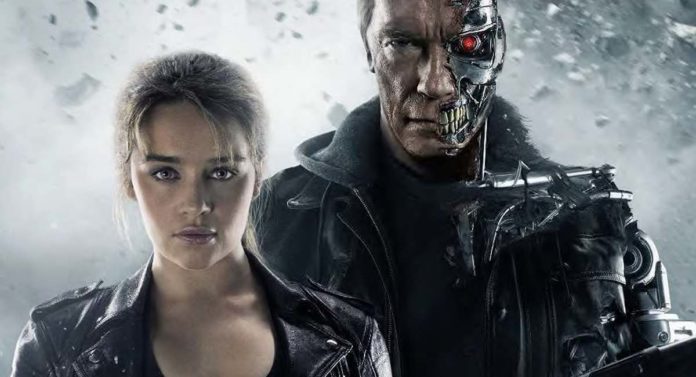Unlike 2014’s abysmal box office low, 2015 saw one of the most successful summers in Hollywood history. Nice work, everyone! All that’s left to do is churn out a quirky arthouse film about a sad Steve Carell and call it a year, right? Only here’s the thing …

All that sweet blockbuster bank was primarily made by two studios, while everyone else took a beating like Vincent D’Onofrio during the blanket party scene in Full Metal Jacket. In fact, 2015’s success falls squarely on the four top-earning films. Everything else either did the same as 2014 or bombed spectacularly. So what in the world happened? Have Disney and Universal finally hoarded all the marketable franchises to form an unbeatable uber-duo like a corporate Tango and Cash? Or is there some detectable reason so many studios failed this year? If you ask me, it’s not rocket science. And as we’ve pointed out in the past, there are six simple lessons that the non-theme-park-owning studios can learn for 2016 …
#6. We Don’t Need Elaborate Origin Stories Anymore

Despite being the first Mad Max adventure in 30 years, Mad Max: Fury Road treated character backstory like post-apocalyptic gasoline — rationing off very little while assuming that audiences were familiar with the basic concepts of “loss” and “nuclear annihilation.” After all, thanks to every new Terminator film, we’ve been repeatedly walked through the nuclear holocaust like it’s a goddamn team-building mantra.


 Somehow, I’m bored by the fiery deaths of millions.
Somehow, I’m bored by the fiery deaths of millions.
Just how many times do they think we need a movie about stopping Judgment Day before the series can die? Every new Terminator film neurotically fears that the audience has never seen the previous one, spending at least 10 percent of its runtime re-explaining the entire franchise. It’s almost as frustrating as Peter Parker’s doomed life as an eternal teenager, watching his Uncle Ben get murdered and reborn over and over like a wailing Prometheus.
 Rumors of a freak encounter with a radioactive spider still swirl!
Rumors of a freak encounter with a radioactive spider still swirl!
Superhero films are the worst when it comes to obsessively retelling origin stories. Every new reboot apparently thinks that the audience has somehow forgotten everything about the previous film and will welcome a Nolan-like reimagining. Speaking of Nolan, Batman Begins didn’t succeed because it focused on Bruce Wayne’s parents dying for the third time on film, but because it showed the previously-unseen years between their deaths and his decision to become a tactical crime-fighting giant mouse. But thanks to that film, we now have a Fantastic Four movie that spends two-thirds of its time lumbering through expository sequences wherein its four main characters stand around frowning at each other.
 And the actors do the same while off-camera.
And the actors do the same while off-camera.
Generally speaking, an origin story serves two main purposes: 1) It eases the audience into accepting and understanding the universe of the film, and/or 2) It show us the origin of an iconic character for the purpose of entertainment. The key is knowing what needs an explanation and what doesn’t. For example, Star Wars had faith that audiences would accept “a galaxy far, far away” as enough justification for spaceships, aliens, and some intergalactic war, but it also knew that unique concepts like lightsabers and the Force needed to be slowly introduced along the way. Unlike the prequels’ obsession with the thrilling nuance of trade route taxation disputes, the original films understood that audiences were sophisticated enough to accept a basic “good vs evil” plot. I bring up Star Wars because it was the clear glimmer in the eye of the sibling duo behind this hot sack of crap:
 Dog Soldiers II: Byzantine Space Politics
Dog Soldiers II: Byzantine Space Politics
Jupiter Ascending follows the winning Star Wars plot about a complacent rando becoming a space warrior, but noisily shits the bed in assuming it needs to spend its first 40 minutes furiously over-explaining the origins of everything from a complicated dispute between alien dynasties to the bureaucratic process of being registered as space royalty. (Seriously, there’s an extended sequence in the middle of the film in which the main character has to slog through what is essentially a Space DMV.) There’s even a scene of the protagonist being born, as if the filmmakers were afraid that we wouldn’t understand how she came to exist otherwise.
We don’t need any of that stuff. Spend as little time as possible explaining the parts that are absolutely necessary, and let the story tell the rest. This is one of many reasons this new Wachowski film bombed unceremoniously — another being that it was made by the Wachowskis. Which segues perfectly into the next point …
#5. Studios Keep Betting On Actors And Directors Who Never Make Money

After Jupiter Ascending pulled the box office equivalent of drowning in urine, Deadline issued this incredulous crow of a headline:

Yes. How could it be that the makers of Speed Racer, Cloud Atlas, and The Matrix Revolutions created a subpar sci-fi / fantasy film? Oh wait:
 Jupiter Ascending was advertised as being from the creators of The Matrix — a 16-year-old movie.
Jupiter Ascending was advertised as being from the creators of The Matrix — a 16-year-old movie.
It turns out that the Wachowski siblings have literally never made a beloved or marketable film since The Matrix. And yet, for some unfathomable reason, their last three flops had respective budgets of $176 million, $102 million, and $120 million. It’s almost as if the people giving them money are in some spiraling state of denial about the fact that this duo only had one good story to tell. And they aren’t alone in the shitter, either.
George Clooney is a great and universally fuckable actor, but barely any of his headlining films have broken the $100 million mark:
 And the only one to break $200 million killed him off after half an hour.
And the only one to break $200 million killed him off after half an hour.
Yet for some reason, Tomorrowland had a budget over $100 million. Why? Did they think he was finally due? I get that Brad Bird is a director with a bunch of huge hits under his belt, but why wouldn’t they have used a portion of that gigantic budget to hire a lead with mainstream appeal? The same goes for Arnold Schwarzenegger, who hasn’t cracked $100 million solely on his presence in over a decade. This makes the $155 million spent on Terminator Genisys an act of a money-hating terrorism.
I know it sounds callously un-progressive to imply that studios shouldn’t let actors lob a good buzzer beater every now and then, but there’s a difference between cautiously investing in a spunky underdog and going all-in on a rotting dachshund. I’m not saying that the Wachowskis should be purged from Hollywood, but rather that studios should stop dogmatically throwing so much money at every story they conjure about rocket-skating dog people fighting dinosaurs in leather jackets. It’s depressing that I have to even propose that, and that the previous sentence is in no way a joke.
#4. No One Wants To Watch A Movie With Millions Of Villains Packed In It

Quick: Name a good movie with more than two iconic villains in it. And by “iconic villain,” I mean a fully-fleshed-out, single character who made an impact on the audience, and not a cluster of villains like the Baseball Furies from The Warriors or Jurassic Park‘s raptors. Also, the villains have to be in only one film, meaning that stuff like Return Of The Jedi, Return Of The King, or any of the Harry Potters don’t count, because their characters had multiple films in which to be fleshed out.
I know that sounds like I’m arbitrarily making up rules, but what I’m getting at is that in order for a villain like Boba Fett or Bellatrix Lestrange to be memorable, they need a lot of elbow room to become formidable and sexy and scary. And so with a standalone, 90-to-120-minute film, the greater number of bad guys you stick in, the less time you have to make each character memorable in any way. I feel like now is as good of a time as any to point out that Terminator Genisys has four villains in it.
 From top to bottom: T-800, T-1000, T-3000, and T-5000. Because if we can’t improve the story, we’ll improve the model numbers.
From top to bottom: T-800, T-1000, T-3000, and T-5000. Because if we can’t improve the story, we’ll improve the model numbers.
Four. Two of whom are killed in the first half of the film, while the other two only show up near the end. At no point is a considerable amount of time spent on even one of these killer robots, making none of them remarkable in any way. You could argue that Robot John Connor was supposed to be the main villain, but given that you don’t see him until the halfway point, it’s monumentally challenging to give a shit.
Any first-year film student will tell you that most movies tend to introduce the main antagonist and/or obstacles in the first act of a film. In the first 30 minutes of Age Of Ultron, Furious 7, and Jurassic World, we know exactly who or what the villain is and what problem they’re causing. By its 12-minute mark, Mad Max: Fury Road has given us its main villain, heroes, and the inciting action that sets the rest of the film into motion. This is how action and adventure movies are supposed to work, and why I get full-body mystery pain when I look at the Batman V. Superman cast and see half of DC’s lineup:
 The post-credits teaser will feature Jonah Hex, Swamp Thing, Black Canary, and Alley-Kat-Abra.
The post-credits teaser will feature Jonah Hex, Swamp Thing, Black Canary, and Alley-Kat-Abra.
Maybe I’m a pessimist, but there’s no worldly way to make all those characters compelling with the little amount of introductory screen time they’re getting. That’s why Marvel didn’t start with The Avengers and make individual films later, and why DC isn’t being innovative by doing the opposite. Meanwhile, Pixels had three mini-bosses that came and went, and Jupiter Ascending juggled more half-formed and badly-motivated shifties than a Robin Thicke concert. It sounds so basic, but most of the worst-rated blockbusters films this year seemed to forget that you need to spend time establishing a single villain. And the failure doesn’t even have to be oversaturation; while Fantastic Four only had Dr. Doom to work with, they inexplicably introduced him in the final leg of the film, in what was arguably its only compelling moment.
 Relatively speaking.
Relatively speaking.
If you’re wondering why the film didn’t simply start with Dr. Doom rampaging around and blowing up heads, it’s because everyone assumed there would be plenty of time for that in the sequel. Which reminds me …
#3. Movies Need To Stop Assuming They’re Getting Sequels

When attempting to prime audiences for the inevitable disappointment of Fantastic Four, director Josh Trank told a Comic-Con audience that the film “almost works as a prequel” to the theoretical sequel which we now know it will never have. Not only is this the most insane justification ever, but it’s also a perfect representation for how badly Marvel Studios’ success clouds the judgment of every writer and director. Big-budget movies are no longer made as single-serving stories, but under the bold assumption that they are only one installment of a vast network of sequels and spin-offs. And while there’s nothing wrong with planning ahead a little bit, treating your film like its the first act of a three-act play will either take away from the story you’re trying to tell or become flat-out embarrassing if nobody likes it and you never get to make another one. Case in point:
 For those of you enjoying this column, here’s the punchline from a joke in my next one,
For those of you enjoying this column, here’s the punchline from a joke in my next one,
devoid of all context: “You’re an asshole when you’re drunk, Superman.”
And so, once again I have to drag out Terminator Genisys, a film that glossed over why Arnold Schwarzenegger was sent back to kick-start an alternate timeline and which ultimately baffled audiences. When asked about this, the director said that the film was written with the intent of being a trilogy, and that a later film would answer a lot of the taunting plot holes in the first one. This is the equivalent of setting a house on fire while you’re building it, and then reassuring everyone that the second floor will have an extinguisher. Tell a complete, sensical story, you franchise cannibal.
If you don’t remember, it was this mindset that almost ruined Age Of Ultron for audiences, as the studio was so obsessed with setting up future films that they stuck in a gibberish cave sequence and almost made Joss Whedon’s beautiful head implode. It’s also partially why we didn’t get to see Edgar Wright make Ant-Man, a film which Marvel considered to be more of a two-hour ad for Phase Four than a standalone story.

Because when else will they have the opportunity to promote future films?
Here’s an interesting fact: The new Mad Max was originally supposed to be two films shot back-to-back, one of which focused on the Furiosa character. Somewhere along the way, it became more sensible to consolidate all of the awesomeness into the single genital-engorging movie now holding a 97 percent on Rotten Tomatoes. When recently asked about the possibility of a sequel, director George Miller compared the question to asking someone who just gave birth when their next baby is due. In other words, he considers Mad Max a work of passion, and not the first hitch on a chain of marketable products … Otherwise known as how storytelling is supposed to work.
But this is merely one of the many reasons Mad Max is currently the highest-rated film of the year …
#2. The Best Movies This Year Knew Exactly Who They Were Made For

The stupid simple reason Mad Max is 2015’s best-rated film on Rotten Tomatoes is that anyone who wouldn’t like the film didn’t go see it in the first place. On opening weekend, 54 percent of Fury Road‘s audience was over the age of 35 and presumably made up of fans of the original film. Meanwhile, Pitch Perfect 2 was cleaning house due to being primarily aimed at young female audiences. Both of these films refused to cast a wide net, and therefore appealed to a specific group guaranteed to fill the seats. Unlike many remakes of and sequels to ’80s action films, Fury Road didn’t downgrade to a PG-13 rating to appeal to younger crowds, because doing so would have alienated its actual audience. Gee, if there was only a recent example which was also based off an R-rated ’80s film I could compare that to …
 Begone, spirit! Torment me no longer!
Begone, spirit! Torment me no longer!
Oh, hello again! Terminator is a franchise that no one under the age of 17 gives a wheezing duck fart about. Its star hasn’t made a memorable film in two decades — which, incidentally, is exactly how long it’s been since there was a good Terminator film. Terminator Genisys‘ best possible hope to succeed would be to appeal to the fans who grew up with the series. But instead of embracing that, the producers of Terminator Genisys opted for a PG-13 rating, even though 65 percent of its audience was over 25. By trying to appeal to everybody, they effectively made a film for nobody. In a way, it’s almost impressive how skillfully the movie dodged every marketable demographic like a ninja flipping through an arrow onslaught. However, Genisys is but a journeyman compared to the superior ranks of the forsaken mighty …
 “People keep sharing pictures of wacky mustaches on Facebook, so what if we made an
“People keep sharing pictures of wacky mustaches on Facebook, so what if we made an
entire movie about one?” — Someone who gets paid more than me, somehow.
Yeah, remember that piece of shit? Mortdecai made a cringeworthy $10 million in its first weekend, and has since barely made back half of its $60 million budget. But what’s worse is that anyone expected otherwise, as this film about Johnny Depp playing a goofy eccentric clown was inexplicably rated R — as in, it was restricted from the only people who would possibly want to see Jack Sparrow do silly walks on camera. Seriously, who was this movie even for? What fictional demographic were the executives imagining when they released this cinematic enigma?

Although Clooney was clearly high for that photo.
There’s no good reason the aged star of Monuments Men and The Descendants should be the selling point for a carnival kids’ movie. Nor should an Adam Sandler film about ’80s video games be rated anything less than R. I’m not a mystical shaman, but all this requires is a basic knowledge of how time works. If your movie is about something only old people will remember, then make it for old people. If it’s a dino-wrangling sequel to a PG-13 film from the ’90s, you can probably stick Star Lord in there for the kids. And for the love of God, don’t put an indie director whose one success is a low-budget found footage film in charge of your hundred-million-dollar superhero movie.
#1. Stop Giving Budding Indie Directors Multi-Million-Dollar Franchises

Holy shit, guys. Fantastic Four was more drawn out and disheartening than watching a monkey starve to death. It took place exclusively indoors, had the color scheme of Chernobyl, and went on for 40 minutes before the superheroes got their powers. It was the closest thing to an anti-film I’ve yet seen — dwelling in the stark mantle beneath a dying field of happiness, like a cold drainage ditch full of dead children. If you think I’m being dramatic, then you clearly haven’t seen this movie.
 “… for when you gaze long into the abyss. The abyss gazes also into you …” — James Cameron
“… for when you gaze long into the abyss. The abyss gazes also into you …” — James Cameron
Let’s examine what happened, starting with the fact that Fox decided to go with a director whose only other film was a $12 million found footage movie made popular by darkly subverting the comic book genre.
 Who would have thought that the ominous tagline was about Josh Trank all along?
Who would have thought that the ominous tagline was about Josh Trank all along?
Everything that made Chronicle a success was based around the novelty of grumpy flying teenagers, coupled with its $120 million return against a ridiculously small budget. But when compared to the 2005 Fantastic Four, those numbers are still three times less than Michael Chiklis in a rubber shit-suit. In other words, there’s no reason to think that audiences would want a dark Fantastic Four. Considering how similar Trank’s only two films are, it stands to reason that they’d even make the same amount of money … which they did.


Being essentially the same gritty take on superheroes, both Chronicle and Fantastic Four totaled around $130 million dollars when the dust cleared. But as you might have noticed from the numbers above, only one of these films was made on a micro-budget.
What I’m getting at here is that there’s no smart reason to take a hotshot indie director with one experimental film under his belt and give him $120 million to kick-start a tentpole franchise. Marvel and Universal get away with it because they pick safe directors and micromanage every nuance of the production; something Sony clearly refused to do. But even when the studios are breathing down necks, this modern process of dragging a director straight from indie to blockbuster and skipping over the mid-budget film stage is fucking ludicrous. Not only because it presents a constant gamble on the studio’s behalf, but also because it’s simultaneously preventing us from discovering the next Spielberg or Cameron. Remember these films?
 Hint: They both starred hulking blocks of thoughtless murder muscle.
Hint: They both starred hulking blocks of thoughtless murder muscle.
Both of these were made for less than $10 million. Afterwards, both directors went on to make drastically different films about the same subject, called Close Encounters Of The Third Kind and Aliens. Those films cost around $20 million to make. From there, both directors continued to slowly increase their budgets. Jim Cameron spent $70 million on The Abyss, while Spielberg spent a combined $100 million to make E.T. and the first three Indiana Jones films. Cameron didn’t get a $100 million budget until Terminator 2, and Spielberg didn’t spend that much money on a single film until fucking 2002, when he made Minority Report. And when you think about it, this is exactly how the system should work.
 When Jim Cameron asks for $200 million to do Dances With Ferngully, it’s because he’s earned that trust, dammit.
When Jim Cameron asks for $200 million to do Dances With Ferngully, it’s because he’s earned that trust, dammit.
If you’re a first-week cashier at a Hardee’s, you aren’t expected to run the meth lab in the back by week two. Similarly, if you just made a film called “Elite Squad” for $16 million, you wouldn’t expect to be making a Robocop reboot for $130 million. That’s a stupid and reckless gamble every time.
And the saddest part isn’t that it’s ruining the films, but rather the directors who might have otherwise gone on to make great films of their own (to be rebooted 20 years later by a whole new crop of directors). Chronicle was a strong concept that, if followed with a mid-budget film instead of a bloated superhero franchise, might have started a good career instead of imploding it. Gambling with new directors also means gambling with those directors’ careers. Consequently, a guy like Alan Taylor might successfully go from TV shows to Thor: The Dark World, but can still ruin Terminator Genisys due to his lack of experience. Gareth Edwards went from a $500,000 indie film to a fucking $160 million Godzilla film in four years, and is now making the next Star Wars movie, even though he only has two previous credits to his name, both of which are giant monster movies.
 Beware: This movie is 90 percent aimless wandering.
Beware: This movie is 90 percent aimless wandering.
It’s like the studio executives are frantically running around tossing various directors on random projects like they’re on a Nickelodeon game show, all while competing for who can blindly eat the largest wad of money. Because for some ungodly reason, Hollywood has forgotten how to make a modestly-budgeted film.
And that’s why I’m so bummed out by headlines like this …

Read more here: http://www.cracked.com/







